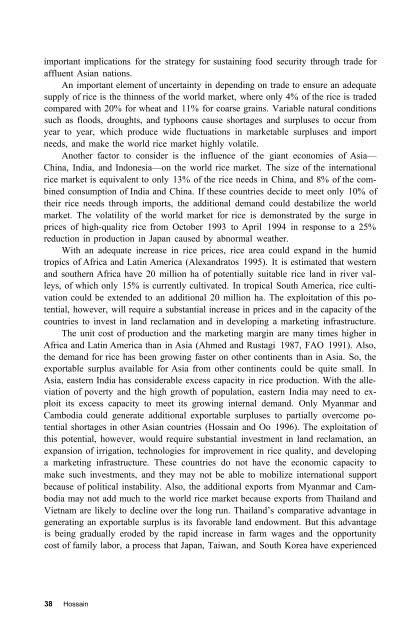Sustainability of rice in the global food system - IRRI books
Sustainability of rice in the global food system - IRRI books
Sustainability of rice in the global food system - IRRI books
Create successful ePaper yourself
Turn your PDF publications into a flip-book with our unique Google optimized e-Paper software.
important implications for <strong>the</strong> strategy for susta<strong>in</strong><strong>in</strong>g <strong>food</strong> security through trade for<br />
affluent Asian nations.<br />
An important element <strong>of</strong> uncerta<strong>in</strong>ty <strong>in</strong> depend<strong>in</strong>g on trade to ensure an adequate<br />
supply <strong>of</strong> <strong>rice</strong> is <strong>the</strong> th<strong>in</strong>ness <strong>of</strong> <strong>the</strong> world market, where only 4% <strong>of</strong> <strong>the</strong> <strong>rice</strong> is traded<br />
compared with 20% for wheat and 11% for coarse gra<strong>in</strong>s. Variable natural conditions<br />
such as floods, droughts, and typhoons cause shortages and surpluses to occur from<br />
year to year, which produce wide fluctuations <strong>in</strong> marketable surpluses and import<br />
needs, and make <strong>the</strong> world <strong>rice</strong> market highly volatile.<br />
Ano<strong>the</strong>r factor to consider is <strong>the</strong> <strong>in</strong>fluence <strong>of</strong> <strong>the</strong> giant economies <strong>of</strong> Asia—<br />
Ch<strong>in</strong>a, India, and Indonesia—on <strong>the</strong> world <strong>rice</strong> market. The size <strong>of</strong> <strong>the</strong> <strong>in</strong>ternational<br />
<strong>rice</strong> market is equivalent to only 13% <strong>of</strong> <strong>the</strong> <strong>rice</strong> needs <strong>in</strong> Ch<strong>in</strong>a, and 8% <strong>of</strong> <strong>the</strong> comb<strong>in</strong>ed<br />
consumption <strong>of</strong> India and Ch<strong>in</strong>a. If <strong>the</strong>se countries decide to meet only 10% <strong>of</strong><br />
<strong>the</strong>ir <strong>rice</strong> needs through imports, <strong>the</strong> additional demand could destabilize <strong>the</strong> world<br />
market. The volatility <strong>of</strong> <strong>the</strong> world market for <strong>rice</strong> is demonstrated by <strong>the</strong> surge <strong>in</strong><br />
p<strong>rice</strong>s <strong>of</strong> high-quality <strong>rice</strong> from October 1993 to April 1994 <strong>in</strong> response to a 25%<br />
reduction <strong>in</strong> production <strong>in</strong> Japan caused by abnormal wea<strong>the</strong>r.<br />
With an adequate <strong>in</strong>crease <strong>in</strong> <strong>rice</strong> p<strong>rice</strong>s, <strong>rice</strong> area could expand <strong>in</strong> <strong>the</strong> humid<br />
tropics <strong>of</strong> Africa and Lat<strong>in</strong> America (Alexandratos 1995). It is estimated that western<br />
and sou<strong>the</strong>rn Africa have 20 million ha <strong>of</strong> potentially suitable <strong>rice</strong> land <strong>in</strong> river valleys,<br />
<strong>of</strong> which only 15% is currently cultivated. In tropical South America, <strong>rice</strong> cultivation<br />
could be extended to an additional 20 million ha. The exploitation <strong>of</strong> this potential,<br />
however, will require a substantial <strong>in</strong>crease <strong>in</strong> p<strong>rice</strong>s and <strong>in</strong> <strong>the</strong> capacity <strong>of</strong> <strong>the</strong><br />
countries to <strong>in</strong>vest <strong>in</strong> land reclamation and <strong>in</strong> develop<strong>in</strong>g a market<strong>in</strong>g <strong>in</strong>frastructure.<br />
The unit cost <strong>of</strong> production and <strong>the</strong> market<strong>in</strong>g marg<strong>in</strong> are many times higher <strong>in</strong><br />
Africa and Lat<strong>in</strong> America than <strong>in</strong> Asia (Ahmed and Rustagi 1987, FAO 1991). Also,<br />
<strong>the</strong> demand for <strong>rice</strong> has been grow<strong>in</strong>g faster on o<strong>the</strong>r cont<strong>in</strong>ents than <strong>in</strong> Asia. So, <strong>the</strong><br />
exportable surplus available for Asia from o<strong>the</strong>r cont<strong>in</strong>ents could be quite small. In<br />
Asia, eastern India has considerable excess capacity <strong>in</strong> <strong>rice</strong> production. With <strong>the</strong> alleviation<br />
<strong>of</strong> poverty and <strong>the</strong> high growth <strong>of</strong> population, eastern India may need to exploit<br />
its excess capacity to meet its grow<strong>in</strong>g <strong>in</strong>ternal demand. Only Myanmar and<br />
Cambodia could generate additional exportable surpluses to partially overcome potential<br />
shortages <strong>in</strong> o<strong>the</strong>r Asian countries (Hossa<strong>in</strong> and Oo 1996). The exploitation <strong>of</strong><br />
this potential, however, would require substantial <strong>in</strong>vestment <strong>in</strong> land reclamation, an<br />
expansion <strong>of</strong> irrigation, technologies for improvement <strong>in</strong> <strong>rice</strong> quality, and develop<strong>in</strong>g<br />
a market<strong>in</strong>g <strong>in</strong>frastructure. These countries do not have <strong>the</strong> economic capacity to<br />
make such <strong>in</strong>vestments, and <strong>the</strong>y may not be able to mobilize <strong>in</strong>ternational support<br />
because <strong>of</strong> political <strong>in</strong>stability. Also, <strong>the</strong> additional exports from Myanmar and Cambodia<br />
may not add much to <strong>the</strong> world <strong>rice</strong> market because exports from Thailand and<br />
Vietnam are likely to decl<strong>in</strong>e over <strong>the</strong> long run. Thailand’s comparative advantage <strong>in</strong><br />
generat<strong>in</strong>g an exportable surplus is its favorable land endowment. But this advantage<br />
is be<strong>in</strong>g gradually eroded by <strong>the</strong> rapid <strong>in</strong>crease <strong>in</strong> farm wages and <strong>the</strong> opportunity<br />
cost <strong>of</strong> family labor, a process that Japan, Taiwan, and South Korea have experienced<br />
38 Hossa<strong>in</strong>

















